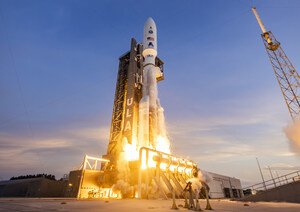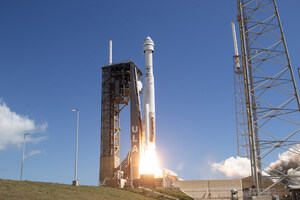United Launch Alliance Successfully Launches Critical National Security Mission direct to GEO
CAPE CANAVERAL SPACE FORCE STATION, Fla., Dec. 7, 2021 /PRNewswire/ -- A United Launch Alliance (ULA) Atlas V rocket carrying the Space Test Program (STP)-3 mission for the U.S. Space Force's Space Systems Command lifted off on Dec. 7 at 5:19 a.m. EST from Space Launch Complex-41 at Cape Canaveral Space Force Station. To date ULA has launched 147 times with 100 percent mission success. STP-3 marked ULA's longest duration mission at seven hours and 10 minutes until spacecraft separation.
"Today's launch is a testament to why the ULA team continually serves as our nation's most reliable and successful launch provider for our country's most critical space assets," said Gary Wentz, ULA vice president of Government and Commercial Programs. "Thank you to our U.S. Space Force, NASA and industry teammates for their tremendous partnership in successfully delivering STP-3 to orbit."
Producing more than two and a half million pounds of thrust at liftoff, the Atlas V 551 rocket is the most powerful in the Atlas V fleet. This mission debuted several unique capabilities including the first Out of Autoclave (OOA) Payload Fairing, In-Flight power system and GPS Enhanced Navigation. OOA manufacturing allows for a more efficient production process, lower cost and lower system mass while maintaining the same level of reliability and quality. The In-Flight power system ensures the Space Test Program Satellite-6 (STPSat-6) and Long Duration Propulsive Evolved Expendable Launch Vehicle (EELV) Secondary Payload Adapter (ESPA)-1, (LDPE-1) spacecraft had fully charged batteries when deployed into geosynchronous orbit. The GPS Enhanced Navigation Development Project provides increased spacecraft insertion accuracies a critical addition to this direct to long-duration mission. The booster rate gyro (BoRG) unit is a low-cost alternative rate gyroscope package. The design utilizes simplified processing and commercial inertial measurement units built into a triple-channel architecture to significantly reduce unit cost and weight.
The mission launched on an Atlas V 551 configuration rocket, that included a 5.4 meter payload fairing. The Atlas booster for this mission was powered by the RD AMROSS RD-180 engine. Aerojet Rocketdyne provided the RL10C-1 engine for the Centaur upper stage and Northrop Grumman provided the five Graphite Epoxy Motors (GEM) 63 solid rocket boosters.
This was the 90th launch of the Atlas V rocket. ULA's next launch is the USSF-8 mission for the U.S. Space Force, planned for January 21, 2022, from Cape Canaveral Space Force Station, Fla.
With more than a century of combined heritage, ULA is the nation's most experienced and reliable launch service provider. ULA has successfully delivered more than 145 missions to orbit that aid meteorologists in tracking severe weather, unlock the mysteries of our solar system, provide critical capabilities for troops in the field, deliver cutting-edge commercial services and enable GPS navigation. For more information on ULA, visit the ULA website at www.ulalaunch.com, or call the ULA Launch Hotline at 1-877-ULA-4321 (852-4321).
Join the conversation: Facebook, Twitter, Instagram and LinkedIn.
Photos available on the ULA Flickr page.
SOURCE United Launch Alliance (ULA)

WANT YOUR COMPANY'S NEWS FEATURED ON PRNEWSWIRE.COM?
Newsrooms &
Influencers
Digital Media
Outlets
Journalists
Opted In





Share this article